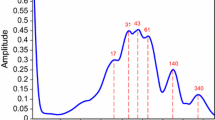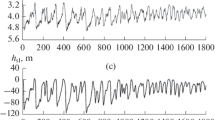Abstract
Slow climatic fluctuations of the World Ocean temperature in the Northern Hemisphere over the past century and a half as a response to the corresponding solar-activity modulations are identified and investigated. It is shown that, taking into account the nonstationary nature of climatic series, the most appropriate method for analysis is the calculation of wavelet spectra. It is found that the maxima of 11-year solar cycles obey long-term modulations with a wide range of quasi-periodicities, in which intervals of the 60–80 year oscillations, as well as the secular and two-century oscillations, are distinguished. These fluctuations are translated into the corresponding oscillations of the sea surface temperature (SST) of the ocean in the tropical zone. In the El Niño indices Niño 1,2 and Niño 4, responsible for SST anomalies in the water area near the coast of South America and in the central part of Pacific tropics, there is a different emphasis on the abovementioned long-term modulation. It can be assumed that 11-year fluctuations in solar activity are translated into short-period quasi-periodic (5–11 years) El Niño oscillations. In turn, long-term modulations, which we call, following previous researchers, the fundamental climatic oscillation (FCO), pass into SST oscillations in the Pacific and Atlantic Oceans, preserving the quasi-periodicity given by fluctuations in solar activity. In turn, the FCO is repeated in a series of the following climate indices: Pacific Decadal Oscillations (PDO) and Pacific North American (PNA) oscillation in the Pacific Ocean, as well as in the Atlantic Multidecadal Oscillation (AMO). The positive phase of AMO that began in the mid-1970s intensified the greenhouse effect on climate warming in the last quarter of the 20th century, but the stabilization of AMO values in the early 21st century led to a known “climate pause” in warming. It is shown that, for the shortened climatic series over the past half century, when the role of satellite measurements was dominant in the estimates of SST anomalies and the considered indices of the World Ocean, similar results were obtained for all wavelet spectra.





Similar content being viewed by others
REFERENCES
Avakyan, S.V. and Voronin, N.A., A possible physical mechanism of the influence of solar and geomagnetic activity on lower atmospheric phenomena, Issled. Zemli Kosmosa, 2006, no. 2, pp. 28–33.
Barnston, A.G. and Livezey, R.E., Classification, seasonality and persistence of low-frequency atmospheric circulation patterns, Mon. Weather Rev., vol. 115, pp. 1083–1126.
Barnston, A.G., Tippett, M.K., L’Heureux, M.L., Li, S., and DeWitt, D.G., Skill of real-time seasonal ENSO model predictions during 2002–11: Is our capability increasing?, Bull. Am. Meteorol. Soc., 2012, vol. 93, no. 5, pp. 631–651.
Bond, N.A., Overland, J.E., Spillane, M., and Stabeno, P., Recent shifts in the state of the North Pacific, Geophys. Res. Lett., 2003, vol. 30, 2183. https://doi.org/10.1029/2003GL018597
Broecker, W.S., Peteet, D.M., and Rind, D., Does the ocean–atmosphere system have more than one stable mode of operation?, Nature, 1985, vol. 315, pp. 21–26.
Brohan, P., Kennedy, J.J., Harris, I., Tett, S.F.B., and Jones, P.D., Uncertainty estimates in regional and global observed temperature changes: A new dataset from 1850, J. Geophys. Res., 2006, vol. 111, D12106. https://doi.org/10.1029/2005JD006548
Chizhevsky, A.L., Zemnoe ekho solnechnykh bur' (The Terrestrial Echo of Solar Storms), Moscow: Mysl’, 1973.
Daubechies, I., The wavelet transform time-frequency localization and signal analysis, IEEE Trans. Inf. Theory, 1990, vol. 36, pp. 961–1004.
Dickson, R.R., Meincke, J., Malberg, S.A., and Lee, A.J., The “great salinity anomaly” in the northern North Atlantic 1968–1982, Prog. Oceanogr., 1988, vol. 20, pp. 103–151. https://doi.org/10.1016/0079-6611(88)90049
Enfield, D.B., Mestas-Nuñez, A.M., and Trimble, P.J., The Atlantic multidecadal oscillation and it’s relation to rainfall and river flows in the continental U.S., Geophys. Res. Lett., 2001, vol. 28, pp. 2077–2080.
Gleissberg, W., Revision of the probability laws of sunspot variations, Sol. Phys., 1973, vol. 30, pp. 539–542.
Gray, L.J., Beer, J., Geller, M., et al., Solar influences on climate, Rev. Geophys., 2010, vol. 48, RG4001. https://doi.org/10.1029/2009RG000282
Hoerling, M.P., Hurrell, J.W., and Xu, T., Tropical origin for recent North Atlantic climate change, Science, 2001, vol. 292, pp. 90–92. https://doi.org/10.1126/science.1058582
Huang Thorne, P.W., Banzon, V.F., et al., Extended Reconstructed Sea Surface Temperatures version 5 (ERSSTv5): Upgrades, validations, and intercomparisons, J. Clim., 2017, vol. 30, no. 20, pp. 8179–8205. https://doi.org/10.1175/JCLI-D-16-0836.1
Hurrell, J.W., Decadal trends in the North Atlantic Oscillation: Regional temperatures and precipitation, Science, 1995, vol. 269, pp. 676–679. https://doi.org/10.1126/science.269.5224.676
Kantelhardt, J.W., Koscielny-Bunde, E., Rego, H.A., Havlin, S., and Bunde, A., Detecting long-range correlations with detrended fluctuation analysis, Phys. A: Stat. Mech. Appl., 2001, vol. 295, nos. 3–4, pp. 441–454.
Khromov, S.P., Some controversies related to the cyclical nature of solar activity and its possible relationship with the climate, Meteorol. Gidrol., 1973, no. 9, pp. 93–98.
Kondratyev, K.Ya., Climatic Effects of Aerosols and Clouds, Springer, 1999.
Kudryavtsev, I.V. and Jungner, H., A possible mechanism of the effect of cosmic rays on the formation of cloudiness at low altitudes, Geomagn. Aeron. (Engl. Transl.), 2005, vol. 45, no. 5, pp. 641–648.
Lean, J., Evolution of the Sun’s spectral irradiance since the maunder minimum, Geophys. Res. Lett., 2000, vol. 27, no. 16, pp. 2425–2428.
Lean, J. and Rind, D., Climate forcing by changing solar radiation, J. Clim., 1998, vol. 11, pp. 3069–3094.
Mantua, N.J., Hare, S.R., Zhang, Y., Wallace, J.M., and Francis, R.C., A Pacific interdecadal climate oscillation with impacts on salmon production, Bull. Am. Meteorol. Soc., 1997, vol. 78, pp. 1069–1079.
McLean, J.D., de Freitas, C.R., and Carter, R.M., Influence of the Southern Oscillation on tropospheric temperature, J. Geophys. Res., 2009, vol. 114, D14104. https://doi.org/10.1029/2008JD011637
Miller, A., Cayan, D., Barnett, T., Graham, N., and Oberhuber, J., The 1976–77 climate shift of the Pacific Ocean, Oceanography, 1994, vol. 7, pp. 21–26.
Nagovitsyn, Yu.A., A nonlinear mathematical model for the solar cyclicity and prospects for reconstructing the solar activity in the past, Astron. Lett., 1997, vol. 23, no. 6, pp. 742–748.
Ogurtsov, M.G., Modern progress in solar paleoastrophysics and long-range solar-activity forecasts, Astron. Rep., 2005, vol. 49, no. 6, pp. 495–499.
Pokrovsky, O.M., Analysis of climate change factors from remote and contact measurements, Issled. Zemli Kosmosa, 2010, no. 5, pp. 11–24.
Pokrovsky, O.M., Quantitative estimates of the impact of the most important factors on global climate change over the past 150 years, Izv., Atmos. Ocean. Phys., 2019a, vol. 55, no. 9, pp. 1182–1188.
Pokrovsky, O.M., Cloud changes in the period of global warming: The results of the international satellite project, Izv., Atmos. Ocean. Phys., 2019b, vol. 55, no. 9, pp. 1189–1197.
Pokrovsky, O.M., Dalyuk, I.V., and Makhotkina, E.L., Comparative analysis of ground-based and satellite measurements of total solar radiation at the Earth’s surface for the territory of Russia, Issled. Zemli Kosmosa, 1999, no. 4, pp. 3–13.
Pokrovsky, O.M., Dalyuk, I.V., and Makhotkina, E.L., The use of actinometric observations in assessing the reliability of the radiation module of the global model of general atmospheric circulation for the territory of Russia, Meteorol. Gidrol., 2001, no. 8, pp. 5–17.
Polyakov, I.V., Alekseev, G.V., Bekryaev, R.V., Bhatt, U.S., Colony, R., Johnson, M.A., Karklin, V.P., Walsh, D., and Yulin, A.V., Long-term ice variability in Arctic marginal seas, J. Clim., 2003, vol. 16, pp. 2068–2075.
Priest, E.R., Solar Magnetohydrodynamics, Dordrecht: Springer, 1982; Moscow: Mir, 1985.
Raspopov, O.M., Shumilov, O.I., Kasatkina, E.A., et al., The nonlinear character of the effect of solar activity on climatic processes, Geomagn. Aeron. (Engl. Transl.), 2001, vol. 41, no. 3, pp. 407–412.
Rayner, N.A., Parker, D.E., Horton, E.B., Folland, C.K., Alexander, L.V., Rowell, D.P., Kent, E.C., and Kaplan, A., Global analyses of sea surface temperature, sea ice, and night marine air temperature since the late nineteenth century, J. Geophys. Res., 2002, vol. 108, no. D14, 4407. https://doi.org/10.1029/2002JD002670
Shumilov, O.I., Kasatkina, E.A., Raspopov, O.M., et al., An estimation of the climatic response to the variations in solar and volcanic activity, Geomagn. Aeron. (Engl. Transl.), 2000, vol. 40, no. 6, pp. 687–691.
Stauning, P., Solar activity–climate relations: A different approach. J. Atmos. Sol.-Terr. Phys., 2011, vol. 73, no. 13, pp. 1999–2012.
Sutton, R.T. and Hodson, D.L.R., Atlantic Ocean forcing of North American and European summer climate, Science, 2005, vol. 309, pp. 115–118.
Swanson, K.L. and Tsonis, A.A., Has the climate recently shifted?, Geophys. Res. Lett., 2009, vol. 36, L06711. https://doi.org/10.1029/2008GL037022
Tan, X., Gan, T.Y., and Shao, D., Wavelet analysis of precipitation extremes over Canadian ecoregions and teleconnections to large-scale climate anomalies, J. Geophys. Res.: Atmos., 2016, vol. 121, no. 24, pp. 14-469–14-478.
Thompson, C.J. and Battisti, D.S., A linear stochastic dynamical model of ENSO. Part II: Analysis, J. Clim., 2001, vol. 14, no. 4, pp. 445–466.
Tippett, M.K. and Barnston, A.G., Skill of multimodel ENSO probability forecasts, Mon. Weather Rev., 2008, vol. 136, no. 10, pp. 3933–3946.
Torrence, C. and Compo, G., A practical guide to wavelet analysis, Bull. Am. Meteorol. Soc., 1998, vol. 79, pp. 61–78.
Trenberth, K.E. and Hurrell, J.W., Decadal atmosphere–ocean variations in the pacific, Clim. Dyn., 1994, vol. 9, pp. 303–319.
Veretenenko, S.B. and Pudovkin, M.I., Effects of Forbush decreases of galactic cosmic rays in total cloudiness variations, Geomagn. Aeron., 1994, vol. 34, no. 4, pp. 38–44.
Viginsky, Yu.I., Tsiklichnost’ i prognozy solnechnoi aktivnosti (Cyclicity and Forecasts of Solar Activity), Leningrad: Nauka, 1973.
Wallace, J.M. and Gutzler, D.S., Teleconnections in the geopotential height field during the Northern Hemisphere Winter, Mon. Weather Rev., 1981, vol. 109, pp. 784–812.
Yasunaka, S. and Hanawa, K., Regime shifts found in the Northern Hemisphere SST field, J. Meteorol. Soc. Jpn., 2002, vol. 80, pp. 119–135. https://doi.org/10.2151/jmsj.80.119
Zhang, X., Sorteberg, A., Zhang, J., Gerdes, R., and Comiso, J.C., Recent radical shifts of atmospheric circulations and rapid changes in Arctic climate system, Geophys. Res. Lett., 2008, vol. 35, L22701. https://doi.org/10.1029/2008GL035607
Author information
Authors and Affiliations
Corresponding author
Ethics declarations
The authors declare that they have no conflicts of interest.
Additional information
Translated by M. Samokhina
Rights and permissions
About this article
Cite this article
Pokrovsky, O.M., Pokrovsky, I.O. Identifying a Fundamental Climatic Oscillation Using Wavelet Analysis of the Combined Data of Ground and Satellite Observations. Izv. Atmos. Ocean. Phys. 57, 1127–1136 (2021). https://doi.org/10.1134/S0001433821090589
Received:
Revised:
Accepted:
Published:
Issue Date:
DOI: https://doi.org/10.1134/S0001433821090589




